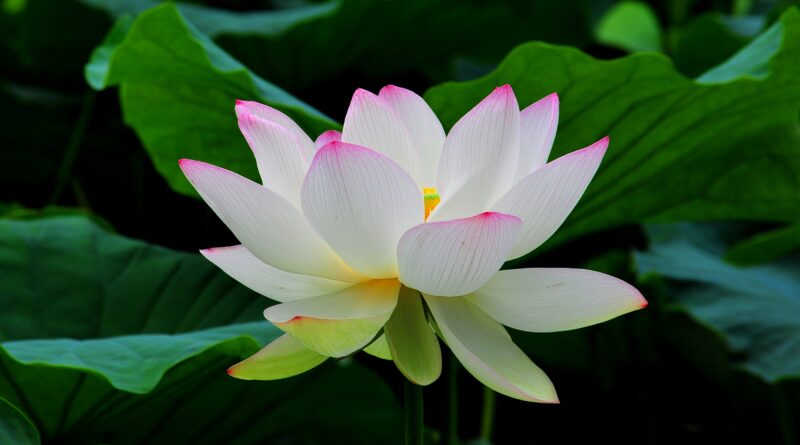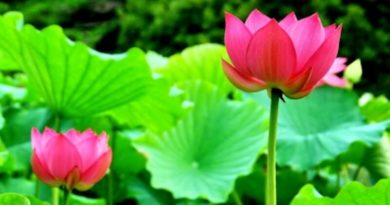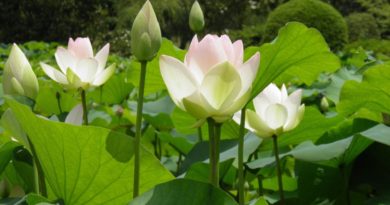ABHIDHAMMA IN DAILY LIFE – CHAPTER 13: FUNCTIONS OF CITTA IN THE SENSE-DOOR PROCESS AND IN THE MIND-DOOR PROCESS
ABHIDHAMMA IN DAILY LIFE – CHAPTER 13: FUNCTIONS OF CITTA IN THE SENSE-DOOR PROCESS AND IN THE MIND-DOOR PROCESS
Each citta has its own function to perform ; no citta arises without performing a function. For example, seeing and hearing are functions performed by citta. We are not used to considering seeing and hearing as functions, because we cling to a self. If we want to know more about cittas we should learn about their different functions.
The first function is the function of patisandhi which is the function of the first citta in life. The second function is bhavanga. The bhavanga-citta keeps the continuity in a lifespan. As long as one is still alive bhavanga-cittas arise and fall away during the time there is no sense-door process or mind-door process of cittas. Bhavanga-cittas arise in between the different processes of cittas which experience an object through one of the six doors. For example, when there is seeing and after that thinking about what was seen, there are different processes of citta and there have to be bhavanga-cittas in between the different processes.
When a rupa impinges on one of the senses the current of bhavanga-cittas is interrupted; there are a few more bhavanga-cittas arising and falling away, and then the panca-dvaravajjana-citta (five-sense-door-adverting-consciousness) arises. The panca-dvaravajjana-citta is the first citta of the process of cittas experiencing the rupa which has come into contact with one of the senses.
The panca-dvaravajjana-citta performs the function of avajjana or adverting to the object which impinges on one of the five senses; it adverts to the object through that sense-door. The panca-dvaravajjana-citta is an ahetuka kiriyacitta.
The ‘Visuddhimagga’ (XIV, 107) states concerning the panca-dvaravajjana-citta (mind-element) :
Herein, the mind-element has the characteristic of being the forerunner of eye-consciousness, etc., and cognizing visible data, and so on. Its function is to advert. It is manifested as confrontation of visible data, and so on. Its proximate cause is the interruption of (the continued occurrence of consciousness as) life-continuum (bhavanga). It is associated with equanimity (upekkha) only.
The panca-dvaravajjana-citta is the ‘forerunner’ because it arises before panca-vinnana (seeing, hearing, etc.). When it adverts to an object which has contacted the eye-sense, it adverts through the eye-door and it is eye-door-adverting-consciousness (cakkhudvaravajjana-citta). When it adverts to an object which has contacted the ear-sense it is ear-door-adverting-consciousness (sota-dvaravajjana-citta). The panca-dvaravajjana-citta is named after the sense-door through which it adverts to the object. The panca-dvaravajjana-citta arises countless times a day, but we do not notice it. Whenever there is seeing, the eye-door-adverting-consciousness (cakkhu-dvaravajjana-citta) has adverted already to the visible object which has impinged on the eye-sense, and it has fallen away already. Whenever there is hearing or any one of the other panca-vinnanas, the panca-dvaravajjana-citta has adverted to the object already and it has fallen away already.
The panca-dvaravajjana-citta is succeeded by the other cittas of the sense-door process which experience that same object. When that process is over, the object is experienced through the mind-door. First there are bhavanga-cittas and then the mano-dvaravajjana-citta (mind-door-adverting-consciousness) performs the function of avajjana (adverting) through the mind-door.
Thus there are two kinds of citta which perform the function of adverting (avajjana-kicca): the panca-dvaravajjana-citta adverts to the object through one of the five sense-doors and the mano-dvaravajjana-citta adverts to the object through the mind-door. The mano-dvaravajjana-citta is an ahetuka kiriyacitta ; it is not accompanied by unwholesome roots (akusala hetus) or by beautiful roots (sobhana hetus). After it has adverted to the object it is followed by kusala cittas or by akusala cittas.
When visible object contacts the eye-sense the eye-door-adverting-consciousness (cakkhu-dvaravajjana-citta) adverts to visible object through the eye-door. When the cakkhu-dvaravajjana-citta has fallen away it is succeeded by seeing-consciousness (cakkhu-vinnana). The function of seeing (in Pali : dassana-kicca) is performed by seeing-consciousness (cakkhu-vinnana). Seeing is vipaka: it is the result of kusala kamma or akusala kamma. We are born in order to receive the results of our deeds and therefore the current of bhavanga-cittas is interrupted and vipakacittas arise after the panca-dvaravajjana-citta.
The citta which performs the function of seeing (dassana-kicca) only sees visible object. This citta does not like or dislike, it is an ahetuka vipakacitta. Neither does it think about the object. If one does not develop right understanding one does not realize that the citta which only sees visible object is a reality different from the citta which likes or disllikes the visible object and different from the citta which pays attention to shape and form. Because of our accumulated ignorance and wrong view we do not realize the impermanence of citta which falls away as soon as it has arisen and which is succeeded by another citta which is a different reality.
There are only two kinds of citta which can perform the function of seeing: one is akusala vipaka and one is kusala vipaka.
When sound has impinged on the ear-sense and the ear-door-adverting-consciousness (sota-dvaravajjana-citta) has arisen and fallen away, hearing-consciousness arises. The function of hearing (in Pali: savana-kicca) is another function of citta. Hearing is ahetuka vipaka. Two kinds of citta can perform the function of hearing: one is akusala vipaka and one is kusala vipaka.
Another function of citta is the function of smelling (in Pali: ghayana-kicca). Two cittas which are both ahetuka can perform this function : one is akusala vipaka and one is kusala vipaka.
There are two kinds of ahetuka citta which can perform the function of tasting (in Pali: sayana-kicca) : one is akusala vipaka and one is kusala vipaka. When the citta which performs this function tastes, for example, a sweet or salty flavour, it merely experiences that taste; it does not know the name of the taste. The cittas which know the conventional name of the taste arise later on.
The function of experiencing impressions through the body-sense (in Pali: phusana-kicca) is another function of citta. When an object contacts the body-sense, the panca-dvaravajjana-citta adverts to the object through the doorway of the body-sense. It is succeeded by body-consciousness (kaya-vinnana) which performs the function of experiencing an impression through the body-sense. Two kinds of citta which are both ahetuka can perform this function: one is akusala vipaka and one is kusala vipaka. The objects experienced by kaya-vinnana are the rupas which are: solidity (experienced as hardness or softness), temperature (experienced as heat or cold), motion (experienced as motion or pressure).
Thus, summarizing the functions performed by the cittas which are the panca-vinnanas, they are:
the function of seeing (dassana-kicca)
the function of hearing (savana-kicca)
the function of smelling (ghayana-kicca)
the function of tasting (sayana-kicca)
the function of experiencing bodily impressions (phusana kicca)
Seeing, hearing, smelling, tasting and experiencing bodily impressions are different functions, not performed by a self, but by citta. These cittas arise because of their own appropriate conditions. In order to remind people of this truth, the Buddha often explained how cittas experience objects through the five senses and through the mind-door. He would point out the different conditions through which cittas arise and the impermanence of these conditions. Since the conditions through which cittas arise are impermanent, cittas cannot be permanent.
We read in the ‘Kindred Sayings’ (IV, Salatana-vagga, Kindred Sayings on Sense, First Fifty, Ch. IV, par. 93, Duality II) that the Buddha said to the monks.
Owing to a dual (thing), monks, consciousness comes into being. And what, monks, is that dual owing to which consciousness comes into being?
Owing to the eye and objects arises eye-consciousness. The eye is impermanent, changing, its state is ‘becoming otherness’. So also are objects. Thus this dual, mobile and transitory, impermanent, changing,- – its state is ‘becoming otherness’.
Eye-consciousness is impermanent, changing, its state is ‘becoming otherness’. This eye-consciousness, arising as it does from an impermanent relation, how could it be permanent?
Now the striking together, the falling together, tile meeting together of these three things (That is: eye, visible object and eye-consciousness.), this, monks, is called ‘eye-contact’. Eye-contact is impermanent, changing, its state is ‘becoming otherness’. That condition, that relation of the uprising of eye-contact, they also are impermanent… This eye-contact, arising as it does from an impermanent relation, how could it be permanent?
Contacted, monks, one feels. Contacted, one is aware. Contacted, one perceives. Thus these states also are mobile and transitory, impermanent and changing. Their state is ‘becoming otherness’…
The same is said with regard to the other doorways.
In the process of citta, the panca-vinnana is succeeded by sampaticchana-citta. This citta, which performs the function of sampaticchana (receiving the object), receives the object after the panca-vinnana has fallen away. Sampaticchana-citta is ahetuka vipaka. Two kinds of citta can perform this function: one is akusala vipaka and one is kusala vipaka.
Kamma does not only produce the dvi-panca-vinnanas (the five pairs) and sampaticchana-citta, it also produces santirana-citta (investigating-consciousness) which succeeds sampaticchana-citta. Santirana-citta performs in the sense-door process the function of santirana (investigating the object) ; it is ahetuka vipakacitta. .
As we have seen (Ch. 9), there are three kinds of santirana-citta which can perform the function of investigating:
- Santirana-citta which is akusala vipaka, accompanied by upekkha.
2. Santirana-citta which is kusala vipaka, accompanied by upekkha.
3. Santirana-citta which is kusala vipaka, accompanied by somanassa (in case the object is extraordinarily pleasant).
Santirana-citta is succeeded by votthapana-citta (determining-consciousness). Votthapana is another function of citta; the votthapana-citta determines the object in the sense-door process. After it has determined the object it is succeeded by kusala cittas or by akusala cittas. The conditions through which it arises are different from the conditions for santirana-citta which is produced by kamma. Votthapana-citta is not vipaka and it is not kusala or akusala but it is an ahetuka kiriyacitta. As we have seen, the votthapana-citta is actually the mano-dvaravajjana-citta which performs the function of votthapana in the sense-door process and is then called votthapana-citta. The mano-dvaravajjana-citta performs two function in the mind-door process it performs the function of adverting to an object through the mind-door, and in the sense-door process it performs the function of votthapana.
If we do not know about the cittas arising in processes and their different conditions we may think that there is a ‘self’ who decides at certain moments to do good deeds or bad deeds. In reality there is no person, no ‘self’ who decides, but there are cittas which are conditioned by accumulations of kusala and akusala.
Cittas experience pleasant or unpleasant objects through the senses and through the mind-door. If someone has accumulated a great deal of lobha and dosa, lobha-mula-cittas are likely to arise when the object is pleasant and dosa-mula-cittas are likely to arise when the object is unpleasant. These cittas arise because of conditions, they are not self, they are beyond control. However, through the study of Dhamma and above all through the development of ‘insight’ there can be conditions for kusala cittas and then there is ‘wise attention’ (yoniso manasikara) to the object. No matter whether the object is pleasant or unpleasant, in the sense-door process the votthapana-citta can be succeeded by kusala cittas and in the mind-door, process the mano-dvaravajjana-citta can, after it has adverted to the object, be succeeded by kusala cittas.
We are inclined to think that in the process of cittas, akusala vipakacittas which experience an unpleasant object should necessarily be followed by akusala cittas, since we let ourselves be ruled by the objects we experience. However, if there is ‘wise attention’ there is no aversion towards unpleasant objects. Kusala cittas and akusala cittas arise because of conditions which are entirely different form the conditions for vipakacittas. Akusala vipaka and kusala vipaka are the result of kamma. We wish to control our vipaka, but this is impossible. When it is time for akusala vipaka, we cannot prevent it from arising. We should realize that our life is nama and rupa, which arise because of condition and fall away immediately. If we would only realize that vipaka is but a moment of citta which falls away as soon as it has arisen, we would be less likely to have aversion towards unpleasant objects we experience.
One may wonder whether it is necessary to know in detail about cittas and their functions. Is it not enough to know only about kusala cittas and akusala cittas? Apart from kusala cittas and akusala cittas we should know also about other kinds of cittas which perform different functions in the processes of cittas and which arise because of different conditions. Then there will be more understanding of the fact that there is no self which can direct the arising of particular cittas at particular moments. There is no self which can decide for kusala cittas. People have different accumulation and thus, when an object presents itselt, there will, in the process of cittas which experience it, be the arising of kusala cittas or akusala cittas, according to one’s accumulations. When, for example, different people smell delicious food, some people may have akusala cittas while others may have kusala cittas. Those who are attached to food are bound to have lobha-mula-cittas. In the case of someone who has accumulations for dana (generosity), kusala citta may arise when he has smelled the food ; he may wish to offer food to the monks. In the case of others again there may be kusala cittas with panna which realizes smell, for example, as only smell, a rupa which is not some ‘thing’, which is devoid of ‘self’. If there can be ‘wise attention’ to the object at this moment, there will be more conditions for ‘wise attention’ in the future.
Kusala cittas and akusala cittas are bound to arise because we have accumulated both kusala and akusala. People are inclined to blame the world for the arising of their defilements since they do not know that defilements are accumulated in the citta; defilements are not in the objects around ourselves. One might wish to be without the six doors in order to have no defilements. However, the only way to eradicate defilements is : knowing the realities which appear through the six doors. We read in the ‘Kindred Sayings’ (IV, Salayatana-vagga, Kindred Sayings on Sense, Fourth Fifty, Ch.III, par. 194, On fire) that the Buddha said to the monks:
I will teach you, monks, a discourse (illustrated) by fire a Dhamma-discourse. Do you listen to it. And what, monks, is that discourse?
It were a good thing, monks, if the organ of sight were seared with a red-hot iron pin, on fire, all ablaze, a glowing mass of flame. Then would there be no grasping of the marks or details of objects cognizable by the eye. The consciousness might stand fast, being firmly bound by the satisfaction either of the marks or the details (of the objects). Should one die at such a time, there is the possibility of his winning one of two destinies, either hell or rebirth in the womb of an animal. Seeing this danger, monks, do I so declare.
It were a good thing, monks if the organ of hearing were pierced with an iron spike, on fire… if the organ of smell were pierced with a sharp claw, on fire… if the organ of taste were seared with a sharp razor, on fire… if the organ of touch were seared with a sword, on fire…
It were a good thing, monks, to be asleep. For sleep, I declare, is barren for living things. It is fruitless for living things, I declare. It is dull for living things, I declare. For (if asleep) one would not be applying his mind to such imaginations as would enslave him, so that (for instance) he would break up the Order. Seeing this danger (of being awake), monks, do I so declare.
As to that, monks, the well-taught Ariyan disciple thus reflects:
‘Let alone searing the organ of sight with an iron pin, on fire, all ablaze, a glowing mass of flame, what if I thus ponder: Impermanent is the eye, impermanent are objects, impermanent is eye-consciousness, eye-contact, the pleasant or unpleasant or neutral feeling which arises owing to eye-contact, – – that also is impermanent…’
So seeing, the well-taught Ariyan disciple is repelled by the eye, by objects, by eye-consciousness, by eye-contact. He is repelled by that pleasant or unpleasant or neutral feeling that arises owing to eye-contact… Being repelled he is dispassionate. Dispassionate, he is set free. By freedom comes the knowledge, ‘I am freed’, so that he realises: ‘Destroyed is rebirth. Lived is the righteous life. Done is the task. For life in these conditions there is no hereafter.’
Such, monks, is the Dhamma-discourse (illustrated) by fire.
This sutta reminds us to be mindful at this moment, when we are seeing, hearing, smelling, tasting, experiencing objects through the body-sense or through the mind-door. All these moments are functions, performed by different cittas which do not last.
-ooOoo-
Questions
- Which citta in a sense-door process determines the object before it is succeeded by akusala a cittas or by kusala cittas? Is it accompanied by hetus (roots) or is it ahetuka?
- Which citta in the mind-door process precedes the kusala cittas or akusala cittas arising in that process? What is its function?
- Is the citta which in the mind-door process precedes the kusala cittas or akusala cittas the first citta of that process experiencing the object ?
- Can this citta be accompanied by wisdom?
- Sound is experienced through the ear-door and through the mind-door. Has the sound fallen away when it is experienced through the mind-door?
- How many types of citta can perform the function of avajjana (adverting)?









